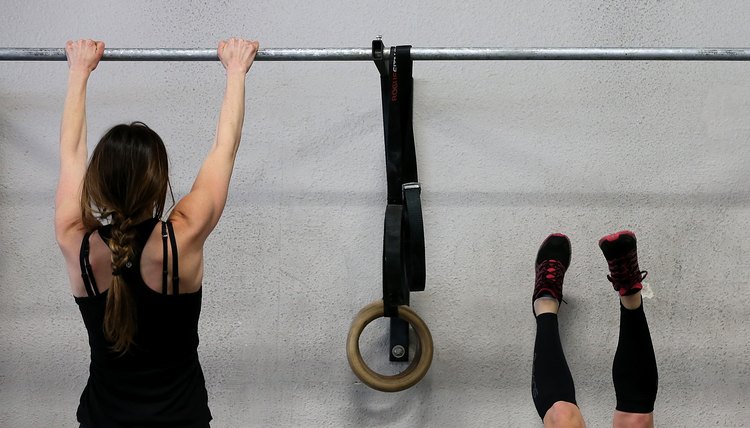What does fact checked mean?
At SportsRec, we strive to deliver objective content that is accurate and up-to-date. Our team periodically reviews articles in order to ensure content quality. The sources cited below consist of evidence from peer-reviewed journals, prominent medical organizations, academic associations, and government data.
The information contained on this site is for informational purposes only, and should not be used as a substitute for the advice of a professional health care provider. Please check with the appropriate physician regarding health questions and concerns. Although we strive to deliver accurate and up-to-date information, no guarantee to that effect is made.
The Antagonist Muscles in a Pull-up

You can design a more balanced workout regimen by identifying the antagonistic muscles for individual exercises. Antagonistic muscle groups move the same joint in opposite directions. Pullup antagonists tend to lengthen as the primary movers shorten during the exercise movement. Pullup antagonist muscles specifically move your shoulders and shoulder blades in the opposite direction of the joint movements that occur while performing pullups.
Deltoids
The lateral and anterior deltoids, or side and front delts, are antagonists during shoulder adduction, which occurs while performing pullups. Shoulder adduction is a medial movement of the shoulder joint toward the midline of your body. Your shoulders adduct as your upper arms move down toward the sides of your body during a pullup. The lateral and anterior deltoids are pullup antagonists because they abduct your shoulders, which is the opposite joint movement that occurs during pullups.
Trapezius
The middle and lower fibers of the trapezius extend from your cervical and thorasic segments of your spine to your shoulder blades. Pullups involve downward rotation of the scapula, which occurs as the inferior angle of the shoulder blades rotates medially and downward. The middle and lower trapezius are pullup antagonists that contract during the opposite joint movement, upward rotation of the scapula. Shoulder presses are an example of upward rotation exercises that activate the middle and lower trapezius.
Supraspinatus
The supraspinatus muscle is one of the four rotator cuff muscles. It stabilizes your the upper arms by holding the top of the humerus, your longer upper arm bone, in place. The supraspinatus is a pullup antagonist, because it is also responsible for abducting your shoulders, which is the opposite movement that occurs during pullups. Lateral raises with dumbbells or cable pulley machines are examples of exercises that involve shoulder abduction, and activate the supraspinatus muscle.
Serratus Anterior
The serratus anterior muscle extends from your upper nine ribs at the sides of your chest to the medial border of each shoulder blade. Activities that draw the shoulder blades forward, such as pushups and bench press exercises, significantly activate the serratus anterior. The serratus is a pullup antagonist that works with the middle and lower trapezius to rotate your shoulder blades upward, which occurs as you reach your arms straight up during exercises, such as shoulder and military presses.
References
Writer Bio
Miguel Cavazos is a photographer and fitness trainer in Los Angeles who began writing in 2006. He has contributed health, fitness and nutrition articles to various online publications, previously editing stand-up comedy and writing script coverage as a celebrity assistant. Cavazos holds a Bachelor of Arts in philosophy and political science from Texas Christian University.
